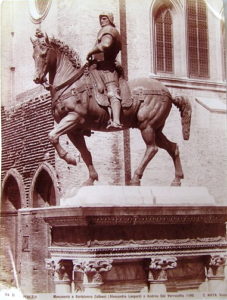 Regular readers of the All About Estates blog may recall that each spring I write on legacy and how we honour the dead. This usually involves a trip to a cemetery. My cemetery visit this year was thwarted by a seagull attack – see my Hitchcockian video – so instead I will turn my attention to a historical bequest and recognition debacle.
Regular readers of the All About Estates blog may recall that each spring I write on legacy and how we honour the dead. This usually involves a trip to a cemetery. My cemetery visit this year was thwarted by a seagull attack – see my Hitchcockian video – so instead I will turn my attention to a historical bequest and recognition debacle.
Bartolomeo Colleoni (1400-1475) was Lombardy-born general who served the Republic of Venice and Duchy of Milan in the 15th century wars on the Italian peninsula. A skilled mercenary, Colleoni was reputedly an evenhanded overlord who improved agricultural methods and was active in charity. Nonetheless, it was his will that secured his place in history.
Colleoni left approximately 650,000 ducats in gold and land to Venice to end the Turkish War. He had one condition. The Republic needed to erect an equestrian statue of Colleoni in Piazza San Marco. The Republic, however, had a strict “no statue” rule for the main square – which even extended to image of St. Mark himself. But the money was too rich to pass up. A bronze statue by Andrea del Verrocchio was erected — but in the nearby Campo Santi Giovanni e Paolo a Venezia opposite La Scuola Grande di San Marco. The School of St. Marks. It was a shoddy sleight of hand by some savvy administrators.
There are a few details about this story that are relevant today.
- Acceptance and Recognition Policies. While no Venetian would have labelled it so, the Republic had gift acceptance and donor recognition policies. No large institutional charity today is without them. These policies categorize assets and assign values to them. They outline who gets recognized, where and in what font size. Recognition is the bait of philanthropy. It needs to be compelling, fair and support the values of the institution. Was Colleoni’s generosity betrayed? Did Venice stay true to its policy? Definitely. To this day there is no statue in the Piazza San Marco.
- Impact v. Recognition. Recognition often deflects the focus from the quality and effectiveness of the charitable works being funded. The charity focuses on announcements, media, guest lists, dinners, signage and statuary. History tells us little about how Colleoni’s bequest was spent – and that can be a challenge for today’s philanthropists as well. Being publicly acknowledged for giving is a deeply meaningful process for most philanthropists, but it is just one facet of the gift.
- Big Philanthropists. As long as there has been personal wealth, there have been influential philanthropists with ambition and generosity. We are at a moment in history that may very well be a golden age of philanthropy, but that doesn’t mean all donations are equally beneficial. Charities, like the Serene Republic, need to have conviction about their mission – the guts to engage, accept and set limits. These gifts require negotiations.
So, when you’re next in Venice go to the island Cimiterio di San Michele. And on the way to the ferry stop, say hello to Colleoni and his magnificent horse.

2 Comments
Catherine Oliver
May 18, 2017 - 1:18 pmLove these lessons from the past.
Charles O'Neil
May 18, 2017 - 5:30 pmWell written article and I love the relevance to today. And who among us have not suffered from shoddy sleight of hand by savvy administrators? However, as a proud Nova Scotian I did take exception to the thinly veiled derogatory comment about seagulls.
Response: This seagull was nasty and deranged. No offense to our maritime colleagues. EDITOR